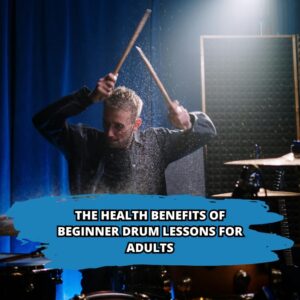
Singing is an art that requires a unique set of skills, and breath control is one of the most important of these skills. Proper breath control is essential for singing with accuracy, power, and emotion. Without it, singers may find it difficult to hit high notes, sustain notes for a long period, and perform with the right tone and clarity. In this article, we will discuss the importance of breath control in singing and provide you with some techniques to improve your vocal performance. If you’d like to get some guidance from a professional teacher book a trail here and see if you’d like to continue with lessons at Elite Music Academy.
Table of Contents
- Introduction
- The Anatomy of Breathing
- The Importance of Breath Control in Singing
- Techniques for Improving Breath Control
- Diaphragmatic Breathing
- Rib Cage Expansion
- Breath Support
- Lip Trills
- Straw Phonation
- Yoga Breathing Exercises
- Conclusion
- FAQs
Introduction
Breath control is an essential component of singing. It is the foundation of all vocal techniques and can greatly affect the quality of the singer’s performance. Breath control is what allows singers to produce sustained notes, articulate words, and express emotions through their voice.
In this article, we will explore the importance of breath control in singing and discuss some techniques that can help singers improve their breath control and vocal performance.
The Anatomy of Breathing
Before we delve into the importance of breath control, let’s take a moment to understand the anatomy of breathing. Breathing is a process that involves the inhalation of air into the lungs and the exhalation of air out of the lungs.
The primary muscles involved in breathing are the diaphragm, intercostal muscles, and abdominal muscles. The diaphragm is a dome-shaped muscle located at the base of the lungs. When we inhale, the diaphragm contracts, pulling down to expand the lungs and create a vacuum that draws air into the lungs. As we exhale, the diaphragm relaxes, pushing up on the lungs and forcing air out.
The intercostal muscles are located between the ribs and help to expand and contract the ribcage during breathing. The abdominal muscles, including the rectus abdominis and obliques, are also involved in breathing by helping to compress the abdominal contents and push up on the diaphragm during exhalation.
The Importance of Breath Control in Singing
Breath control is essential for singers because it directly affects their vocal performance. When a singer has poor breath control, it can result in a weak and strained voice, difficulty hitting high notes, and an inability to sustain notes for a long period.
Proper breath control allows singers to produce a clear and powerful tone, control the pitch and dynamics of their voice, and express emotions through their singing. It also helps to prevent vocal fatigue and strain, which can occur when a singer uses improper breath control and vocal technique.
Techniques for Improving Breath Control
There are several techniques that singers can use to improve their breath control and vocal performance. Here are some of the most effective techniques:
i) Diaphragmatic Breathing
Diaphragmatic breathing is the most important technique for improving breath control in singing. It involves breathing deeply into the diaphragm, rather than shallowly into the chest.
To practice diaphragmatic breathing, lie down on your back and place your hands on your stomach. As you inhale, feel your stomach rise as the diaphragm contracts and pulls down. As you exhale, feel your stomach fall as the diaphragm relaxes and pushes up on the lungs.
ii) Rib Cage Expansion
Rib cage expansion is another technique that can improve breath control in singing. It involves expanding the rib cage as you inhale to increase the amount of air that you can take in.
To practice rib cage expansion, stand with your arms at your sides and your feet shoulder-width apart. As you inhale, expand your rib cage out to the sides and back. You can use your hands to gently push your rib cage outwards. As you exhale, let your rib cage relax back down.
iii) Breath Support
Breath support is the technique of using the abdominal muscles to control the flow of air out of the lungs during singing. This helps to create a steady stream of air that allows singers to sustain notes for longer periods and control the dynamics of their voice.
To practice breath support, stand with your feet shoulder-width apart and your hands on your abdomen. As you inhale, feel your abdomen expand and your diaphragm contract. As you exhale, engage your abdominal muscles to control the flow of air out of your lungs.
iv) Lip Trills
Lip trills are a vocal exercise that can help singers improve their breath control and vocal technique. They involve blowing air through closed lips to create a buzzing sound.
To practice lip trills, close your lips together and blow air out while keeping your lips closed. This should create a buzzing sound. Practice making the buzzing sound while singing different notes.
v) Straw Phonation
Straw phonation is another exercise that can help singers improve their breath control and vocal performance. It involves singing through a straw to create a focused and controlled stream of air.
To practice straw phonation, take a straw and place it in a glass of water. Inhale through your nose and then exhale through the straw while singing different notes. This will create a focused and controlled stream of air that can help improve your breath control and vocal performance.
vi) Yoga Breathing Exercises
Yoga breathing exercises can also be effective for improving breath control in singing. They involve using various breathing techniques to control the flow of air in and out of the lungs.
One effective yoga breathing exercise for singers is the “three-part breath.” To practice this exercise, sit cross-legged on the floor and place your hands on your abdomen, rib cage, and chest. Inhale deeply, feeling your abdomen, rib cage, and chest expand in sequence. Exhale slowly, feeling your chest, rib cage, and abdomen relax in sequence.
Conclusion
In conclusion, breath control is an essential component of singing. Proper breath control allows singers to produce clear and powerful tones, control the pitch and dynamics of their voice, and express emotions through their singing. By practicing techniques like diaphragmatic breathing, rib cage expansion, breath support, lip trills, straw phonation, and yoga breathing exercises, singers can improve their breath control and vocal performance.
FAQs
Q: What is diaphragmatic breathing, and why is it important for singing?
A: Diaphragmatic breathing, also known as belly breathing, is a technique of breathing deeply into the diaphragm rather than shallowly into the chest. It is important for singing because it allows singers to control the amount of air they take in and use it efficiently to create a powerful and sustained sound.
Q: How can rib cage expansion improve my breath control while singing?
A: Rib cage expansion involves expanding the rib cage as you inhale, which increases the amount of air you can take in. This helps to improve breath control by allowing you to take in more air and use it efficiently to create sustained notes, control the dynamics of your voice, and express emotions through singing.
Q: What is breath support, and how can I practice it?
A: Breath support is the technique of using the abdominal muscles to control the flow of air out of the lungs during singing. You can practice it by standing with your feet shoulder-width apart and your hands on your abdomen. As you inhale, feel your abdomen expand and your diaphragm contract. As you exhale, engage your abdominal muscles to control the flow of air out of your lungs.
Q: What are some vocal exercises that can help me improve my breath control?
A: Some vocal exercises that can help improve breath control include diaphragmatic breathing, rib cage expansion, breath support, lip trills, straw phonation, and yoga breathing exercises.
Q: Can yoga breathing exercises really improve my singing?
A: Yes, yoga breathing exercises can help improve your breath control and singing. They involve using various breathing techniques to control the flow of air in and out of the lungs, which can help singers create a powerful and sustained sound.
The Importance of Breath Control in Singing: Techniques for Improved Vocal Performance









